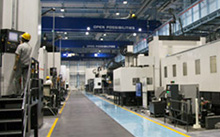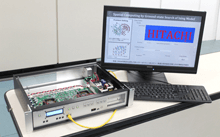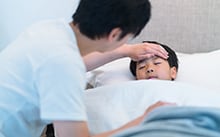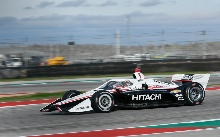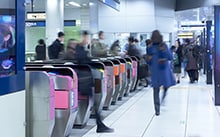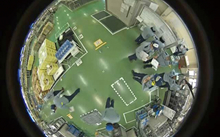It is said that one out of two people in Japan will be diagnosed with cancer, yet Japan's cancer screening rate falls short of the target of 50% put forth by the Ministry of Health, Labour and Welfare, Japan. Despite understanding the importance of early detection, many people cannot take the first step towards an examination, citing lack of time or a busy schedule, a situation exacerbated by the fact that early stages lack symptoms. In light of this, Hitachi researchers posed the following question: Would it not be possible to develop a method for the initial assessment of cancer risk, one simpler than conventional cancer screening, by focusing on urine, which individuals can sample themselves without visiting a medical facility?
■Cancer screening percentages (ages 40 to 69; uterine cancer (cervical cancer) screening: Ages 20 to 69; source: “Overview of Comprehensive Survey of Living Conditions in 2016”, Ministry of Health, Labour and Welfare, Japan) 
Since 1981, cancer has ranked first among causes of death in Japan. Cancer Control and Information, issued by the Ministry of Health, Labour and Welfare, states that currently one in two Japanese is diagnosed with cancer with one in three dying from it. Although Japan's mortality rate is rising, if the impact of the major factor, the aging of society, is excluded, the mortality rate is falling even in the face of the increasing number of cancer diagnoses.*1 This is largely due to the effects of early detection and treatment, along with medical advances. While the government has set a target of 50% for cancer screening, with the exception of lung cancer in men, screening rates are about 30 to 40%.
*1:According to the National Cancer Center, Japan’s Age-adjusted cancer mortality rate under age 75 (mortality rate for all cancers per 100,000), the mortality rate dropped 15.6% over the 10 years of 2005 to 2015, from 92.4 people to 78.0 people.
The cancer screening rate for Japanese is low compared to other OECD countries. Although in recent years, Japan has joined the international community in awareness of breast and cervical cancers in women, a look at their screening only emphasizes how low these rates are. Reasons given for skipping screening often include “lack of time” and “too much bother,” exceeding even “confidence in health” among those in the 40 to 59 age range that actively work. The general attitude is not to submit to medical testing if no changes to physical condition, such as those caused by ordinary diseases, are present. This makes early cancer detection difficult. Rather than dismissing cancer as a problem for others, it is important to view the cancer threat as an intimate issue for oneself and one's family by considering ways of facing it that lead to early detection.
To Hitachi researchers, this situation presented an opportunity to rethink current strategies. They asked themselves, might there not be an everyday way for anyone to face the cancer threat and easily undergo cancer testing that did not involve a medical facility visit? Although cancer screening when no symptoms exist lets us examine the possibility of cancer, the Hitachi research group realized that a gateway to a simpler way of facing the cancer threat was necessary. Taking a novel approach, the group focused on urine.
■Women's cancer screening percentage (OECD Health at a Glance 2015, OECD)
Country (year of survey in parenthesis) |
Cervical cancer screening percentage (aged 20–29) |
Breast cancer screening percentage (aged 50–59) |
|---|---|---|
United States (2012) |
84.5% |
80.8% |
United Kingdom (2013) |
78.1% |
75.9% |
Netherland (2013) |
64.7% |
72.2% |
Australia (2012) |
57.3% |
55.0% |
New Zealand (2013) |
77.0% |
72.2% |
Korea (2013) |
51.7% |
64.3% |
Japan (2013) |
42.1% |
41.0% |
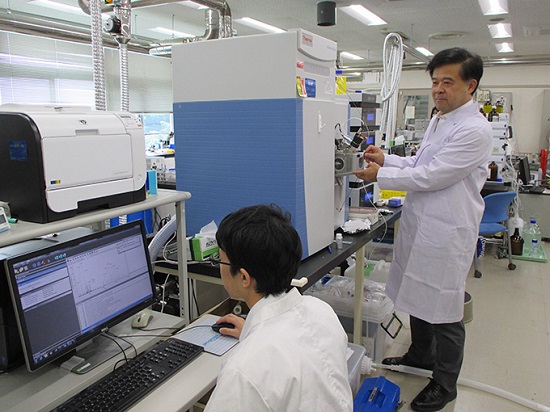
Minoru Sakairi, chief scientist, conducting analysis using the high-resolution liquid chromatograph/mass spectrometer (LC/MS) at the Central Research Laboratory, located in Kokubunji
However, worldwide there were hardly any precedents for cancer testing using urine, obliging researchers to start from scratch. As urine, a substance filtered by the kidneys, was considered to have much less information than blood, it had generated little interest as a specimen for use in cancer screening.
"In fact, urine is actually said to contain nearly 5,000 types of metabolites,” says Minoru Sakairi, chief scientist at Hitachi's Center for Exploratory Research, of the Research & Development Group. "These called for meticulous analysis utilizing state-of-the-art analytical and statistical analysis technologies. We just steadily kept on accumulating such research."
Urine specimens having specific clinical information on whether or not the donor had cancer were sourced from an internationally reliable institution. Over 1,300 detectable metabolites contained therein were then subjected to comprehensive analysis. Substances that serve as indexes of the existence or progress of a certain disease are called “biomarkers.” Those related to cancer, called “tumor markers,” are also indexes of the effectiveness of cancer treatment. Meticulous analysis resulted in the identification of 30 metabolites as candidates for biomarkers capable of discriminating between healthy people and cancer patients. As Sakairi explains:
"For the comprehensive analysis of urine metabolites, we used a liquid chromatograph/mass spectrometer (LC/MS). Taking measurements with an LC/MS, and focusing on differences in the water-and fat-solubility of metabolites so as to optimize measurement conditions, we were able to detect over 1,300 metabolites in the urine samples. Using 30 biomarkers from among these, a look at their measured values for 15 cases each of breast cancer patients, colorectal cancer patients, and healthy subjects showed that we had made a breakthrough in being able to discriminate the difference between cancer and not cancer."

This project demonstrated that urine specimen analysis can be effectively used as an easy gateway to face the cancer threat. Cancer screening is still not a matter that people treat with urgency. However, being able to take the first step is bound to change how they face the cancer threat.
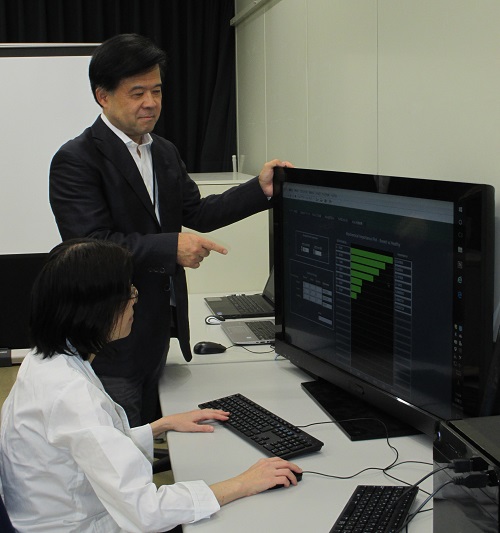
"Conventional blood testing supported one biomarker per test. Urine testing, which we are now investigating, supports multiple biomarkers. This also has the potential to obtain even higher discrimination precision." (Minoru Sakairi, chief scientist)
"In the next research phase, we will partner with domestic university hospitals in using a large number of samples to identify various cancer biomarkers. Increasing the number of biomarker substances is expected to enable the detailed analysis of cancer type, state of progress, and even treatment effects, and can also raise analysis precision." (Minoru Sakairi, chief scientist)
Currently, efforts have also started that are directed at practical applications (test kits, etc.) and achieving their widespread use as a gateway to assisting the individual approach to conventional cancer screening and treatment.
Says Sakairi, "When people become aware of screening via the gateway provided by this easy way of facing the cancer threat, as long as we can put together a way to create a system that enables anyone to undergo robust cancer screening, then I am confident that cancer screening rates will go up."
The Center for Exploratory Research, where the present research is being conducted, is home to cutting-edge research & development carried out with a long-term perspective in collaboration with various research organizations. Using NEXPERIENCE, Hitachi's collaborative creation methodology, the technologies produced here are being developed into practical applications as services for contributing to society. In fact, the urine metabolite cancer discrimination technology resulting from this research is currently the subject of collaborative creation between Hitachi and the insurance company, Aflac. In cooperation with local governments nationwide, Aflac has been carrying out cancer educational activities aimed at promoting a proper understanding of cancer and of raising cancer screening rates. The melding of this experience with Hitachi’s technologies sets a strong foundation for considerations on creating new insurance products and services for promoting early cancer detection and treatment, promising to bring forth contributions to a healthy and enriched society.

As Sakairi concludes, "Even in areas that haven't received much attention in the past, like the subject of this project, we will develop new technologies by conducting the advanced analytical work and statistical analysis that are a part of Hitachi's expertise. This will require the steady accumulation of research, which perhaps could be regarded as our greatest expertise."
Note: Portions of this research project were carried out with the support of the Japan Agency for Medical Research and Development (AMED)'s Acceleration Transformative Research for Medical Innovation, Medical Research and Development Programs.
Release Date: November 2017
Solutions By: Hitachi, Ltd. Research & Development Group

